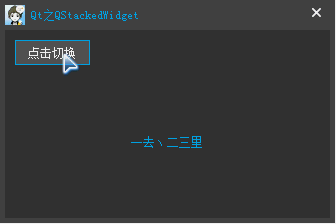简述
QStackedWidget继承自QFrame。
QStackedWidget类提供了多页面切换的布局,一次只能看到一个界面。
QStackedWidget可用于创建类似于QTabWidget提供的用户界面。
使用
一个QStackedWidget可以用一些子页面进行填充。
效果
源码
- 1
- 2
- 3
- 4
- 5
- 6
- 7
- 8
- 9
- 10
- 11
- 12
- 13
- 14
- 15
- 16
- 17
- 18
- 19
- 20
- 21
- 22
- 23
- 24
- 25
- 26
- 27
- 28
- 29
- 30
- 31
- 32
- 33
- 34
- 35
- 36
- 37
- 38
- 39
- 40
- 41
接口
-
int addWidget(QWidget * widget)
添加页面,并返回页面对应的索引
-
int count() const
获取页面数量
-
int currentIndex() const
获取当前页面的索引
-
QWidget * currentWidget() const
获取当前页面
-
int indexOf(QWidget * widget) const
获取QWidget页面所对应的索引
-
int insertWidget(int index, QWidget * widget)
在索引index位置添加页面
-
void removeWidget(QWidget * widget)
移除QWidget页面,并没有被删除,只是从布局中移动,从而被隐藏。
-
QWidget * widget(int index) const
获取索引index所对应的页面
信号
-
void currentChanged(int index)
当前页面发生变化时候发射,index为新的索引值
-
void widgetRemoved(int index)
页面被移除时候发射,index为页面对应的索引值
共有槽函数
-
void setCurrentIndex(int index)
设置索引index所在的页面为当前页面
-
void setCurrentWidget(QWidget * widget)
设置QWidget页面为当前页面
总结
一般情况,常用的两种方式:
-
根据currentWidget()来判断当前页面,然后通过setCurrentWidget()来设置需要显示的页面。
-
根据currentIndex()来判断当前页面索引,然后通过setCurrentIndex()来设置需要显示的页面。








 QStackedWidget是Qt中用于实现多页面切换的布局组件,它继承自QFrame。本文将介绍QStackedWidget的使用方法、主要接口、信号和槽函数,以及在实际应用中的操作技巧,如添加、移除页面及切换当前页面等。
QStackedWidget是Qt中用于实现多页面切换的布局组件,它继承自QFrame。本文将介绍QStackedWidget的使用方法、主要接口、信号和槽函数,以及在实际应用中的操作技巧,如添加、移除页面及切换当前页面等。















 607
607

 被折叠的 条评论
为什么被折叠?
被折叠的 条评论
为什么被折叠?








